The Joys of Public Transport in North East India
(vero;2023-July-15)
Getting to north east India is not difficult but it is so far away from the rest of the country that many people come by plane, a quick and not so expensive solution if you stick to low-cost airlines once in India. We preferred taking a night train from Kolkata to Guwahati: it is even cheaper and a good way of starting the trip (or so we think). It must be said that we are fans of Indian Railways although contrary to what we wrote back in 2016, we now avoid sleeper class for overnight trips, it is simply too crowded and chaotic, we stick to 3A and it is so far perfect for us. The journey is long: 17 hours, but we did not get (too) bored. We had lower berths and for once it was a good point because this meant that we had window seats during the day and could watch the scenery, something to remember next time we travel such long distances involving a good chunk of daytime travel.
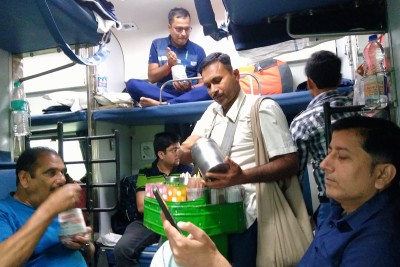 Travelling through the north east is a mixed bag and depends a lot on where you are. Tripura and Assam are good for train travel, but it is road transport for the other states and the distances are such and the roads sometimes so bad that many tourists chose to take the plane to move from one state capital to the other, the only exception being the mountains of Arunachal Pradesh which are only reachable by road. For information, we always booked trains online, an easy procedure once you have an account with Indian Railways (we use an AMEX credit card to pay).
Travelling through the north east is a mixed bag and depends a lot on where you are. Tripura and Assam are good for train travel, but it is road transport for the other states and the distances are such and the roads sometimes so bad that many tourists chose to take the plane to move from one state capital to the other, the only exception being the mountains of Arunachal Pradesh which are only reachable by road. For information, we always booked trains online, an easy procedure once you have an account with Indian Railways (we use an AMEX credit card to pay).
While travelling by road in the north east, you will have to deal with buses, tuk-tuks, Wingers and Sumos, we even travelled in a Force. So what is what?
- A Winger is a minibus manufactured by TATA which can transport (in theory) up to 12 passengers.
- A Sumo is a SUV manufactured by TATA. It can transport 10 passengers (two in front, four in the middle row and four in the back row), although we have often sat in Sumos with 11 passengers (three in the front) and even 12 with some passenger having a child (up to 8-9 years old) on his or her lap… Loads and luggage are transported on the roof, there is hardly any storage space inside.
The names of Winger and Sumo, although specific to TATA are in fact used by extension for all minibuses and SUV-Transporters roaming the roads of the region. Indeed, as our Itanagar-bound Sumo arrived we had the nice surprise to see that it was in fact a "Force", a SUV manufactured by the eponymous Indian company; it is much more comfortable than a TATA-Sumo, with one passenger seat in the front, three distinct seats (and headrests) in a middle row, plus ours had been modified to allow a back row seating two more people, there was plenty of space for our rucksacks inside.
We have described below the transport and connections we used to move around in the north east with prices, duration and our impressions. They are sorted by state following our itinerary.
| Meghalaya | Tripura | Manipur | Nagaland | Assam | Arunachal Pradesh |
Meghalaya
- Guwahati (Assam) to Cherrapunji, 150 km, seven hours in total. Prices per person: Bus Guwahati Paltan Bazaar to ISBT Shillong 180 Rs / Taxi ISBT to city centre 100 Rs / Sumo to Cherrapunji 150 Rs.
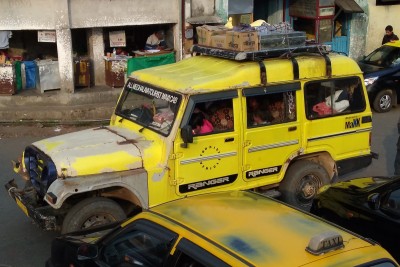 Our first stop after Guwahati (Assam) was the small town of Cherrapunji. To get there, we had to go first to Shillong, Meghalaya's state capital and then change vehicle for Cherrapunji. There was only one Sumo waiting when we showed up at the ASTC station (just south of the railway station) but it was completely empty. We knew there was a bus leaving at 8am but it was fully booked with no ticket available at the counter. After 20 minutes of waiting and the bus about to leave, we decided to try our luck and went straight to the conductor who said that we could board if we did not mind sitting in the crammed front cabin. Of course not! so much more that the fare per person turned out to be 180 Rs instead of 300 Rs with a Sumo. We were very pleased with ourselves, the front cabin was not crammed at all and the journey was not too bad. Alas there was a flaw with this connection: whereas the Sumo would have taken us straight to Shillong's Sumo stand, our bus ended at the ISBT (Inter State Bus Terminal), 10 km north of the centre, which meant we had to take a taxi to get into the city. The only good thing was that we were able to purchase our night bus tickets to Agartala (Tripura) for a week later at the ISBT. Once in Shillong, the traffic was so bad that our taxi got stuck in a jam and we decided to make the last 500m on foot, which meant that we struggled to find the exact place where the Cherrapunji Sumos were departing. We eventually found them in a labyrinth-like two storey parking. The drive to Cherrapunji lasted two hours and we were 11 people in the Sumo. We did not see much of the scenery, squeezed as we were in the middle and we were happy to arrive.
Our first stop after Guwahati (Assam) was the small town of Cherrapunji. To get there, we had to go first to Shillong, Meghalaya's state capital and then change vehicle for Cherrapunji. There was only one Sumo waiting when we showed up at the ASTC station (just south of the railway station) but it was completely empty. We knew there was a bus leaving at 8am but it was fully booked with no ticket available at the counter. After 20 minutes of waiting and the bus about to leave, we decided to try our luck and went straight to the conductor who said that we could board if we did not mind sitting in the crammed front cabin. Of course not! so much more that the fare per person turned out to be 180 Rs instead of 300 Rs with a Sumo. We were very pleased with ourselves, the front cabin was not crammed at all and the journey was not too bad. Alas there was a flaw with this connection: whereas the Sumo would have taken us straight to Shillong's Sumo stand, our bus ended at the ISBT (Inter State Bus Terminal), 10 km north of the centre, which meant we had to take a taxi to get into the city. The only good thing was that we were able to purchase our night bus tickets to Agartala (Tripura) for a week later at the ISBT. Once in Shillong, the traffic was so bad that our taxi got stuck in a jam and we decided to make the last 500m on foot, which meant that we struggled to find the exact place where the Cherrapunji Sumos were departing. We eventually found them in a labyrinth-like two storey parking. The drive to Cherrapunji lasted two hours and we were 11 people in the Sumo. We did not see much of the scenery, squeezed as we were in the middle and we were happy to arrive. - Cherrapunji to Shillong - Bus 100 Rs per person. Driving back to Shillong was very easy in comparison: we wanted to take a Sumo, but just as we arrived at the stand, a bus came onto the square, making a U-turn: we asked where it was heading to and the conductor barked "Shillong ". It was already driving away, we jumped in and off we went. This bus worked for us because our guest house in Shillong was in the south of town and we were able to leave without having to go the whole way to the centre or the ISBT. Since our bags were with us and not bound on a Sumo roof under tons of other stuff, we simply jumped out at the nearest spot to our guest house (thank you GPS). An other good point: we could see the scenery on the way.
- Shillong to Agartala (Tripura), 480 km, nineteen hours. Night Bus 1000 Rs per person / Tuk-tuk to Agartala town centre 60 Rs. We had purchased our ticket at the ISBT in Shillong and the lady at the counter had told us at the time that we could either come to the ISBT by our own means (taxi) or that we could take a complimentary shuttle from the city, pick-up in that case would be on Highway 6 in the south of town at Dhanketi Point (check our map for its location, the "office" is on the grounds of the petrol station). We decided to go for the shuttle because a)
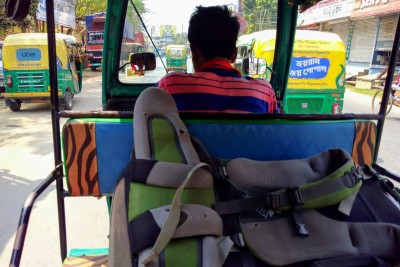 it was free of charge and b) it was not (too) far away from our guest house. The bus was due to leave the ISBT at 16:30 although when we arrived a guy took our tickets and exchanged them with new ones stating a departure time of 17:00. So far so good. We were there at 15:00 and there were already people waiting, so this was quite reassuring, but it was all very haphazard: no waiting space, no seats, uncommunicative guys, nobody seemed to know what was happening. Time went by and we grew a bit nervous but the shuttle appeared at last at 16:15. Although it was past 17:00 when we arrived at the ISBT, we had to wait for our Agartala bound bus and were still very unsure as to which bus, which parking lot, which company… We talked with a Spanish guy living in Meghalaya and on his way to Agartala too. He told us that it was a bit hit and miss as the bus would not wait for passengers: it came from Guwahati, not always at the time scheduled, could be later but also earlier, would disembark and embark passengers and drive away without caring if all booked passengers were here or not. He had missed his bus the day before and here he was again trying his luck. Well, if we had known this before, we surely would not have taken the shuttle and we advise any traveller to go to the ISBT by their own means. The bus was quite comfortable with reclining seats, which was good because the road was bumpy in places. We had a break for dinner around 21:00, all was well and suddenly around midnight a big BANG and here we were with a burst tyre. The repair lasted 2 hours 20 minutes, they had to dismount a first wheel to get access to the one with the burst tyre. We stood in a curve with big lorries regularly passing us in the night, I was really afraid one of them would spot us too late and crash into the bus… Then suddenly a pick-up came from the opposite direction, stopped and four drunk guys stumbled out of the car, all decided to "help" us. That's when we had a bit of a drama: one of our "crew" told them something which they did not like and they became aggressive; they wanted to get to the guy. But he was nowhere to be seen… they became abusive and started looking for him, in the bus, outside of the bus, scanning the passengers, it was all a bit scary and seemed to last a very long time. Then they found him! he was crouched under the bus, so they pulled him out and I thought they would beat him. But three young men from our bus came in between and managed to calm the drunken guys who then decided to leave. That is, two wanted to leave, the other two wanted to stay and they started fighting each other. What a night! They departed at last, our crew finished repairing the tyre and we could continue our journey. So many emotions… but not for Thomas who had stayed in his seat the whole time sound asleep, he even had not noticed when they had rummaged through the bus looking for their "prey". Speak of a clear conscience! Once arrived at Agartala's ISBT, it was easy to find a tuk-tuk into town (60 Rs).
it was free of charge and b) it was not (too) far away from our guest house. The bus was due to leave the ISBT at 16:30 although when we arrived a guy took our tickets and exchanged them with new ones stating a departure time of 17:00. So far so good. We were there at 15:00 and there were already people waiting, so this was quite reassuring, but it was all very haphazard: no waiting space, no seats, uncommunicative guys, nobody seemed to know what was happening. Time went by and we grew a bit nervous but the shuttle appeared at last at 16:15. Although it was past 17:00 when we arrived at the ISBT, we had to wait for our Agartala bound bus and were still very unsure as to which bus, which parking lot, which company… We talked with a Spanish guy living in Meghalaya and on his way to Agartala too. He told us that it was a bit hit and miss as the bus would not wait for passengers: it came from Guwahati, not always at the time scheduled, could be later but also earlier, would disembark and embark passengers and drive away without caring if all booked passengers were here or not. He had missed his bus the day before and here he was again trying his luck. Well, if we had known this before, we surely would not have taken the shuttle and we advise any traveller to go to the ISBT by their own means. The bus was quite comfortable with reclining seats, which was good because the road was bumpy in places. We had a break for dinner around 21:00, all was well and suddenly around midnight a big BANG and here we were with a burst tyre. The repair lasted 2 hours 20 minutes, they had to dismount a first wheel to get access to the one with the burst tyre. We stood in a curve with big lorries regularly passing us in the night, I was really afraid one of them would spot us too late and crash into the bus… Then suddenly a pick-up came from the opposite direction, stopped and four drunk guys stumbled out of the car, all decided to "help" us. That's when we had a bit of a drama: one of our "crew" told them something which they did not like and they became aggressive; they wanted to get to the guy. But he was nowhere to be seen… they became abusive and started looking for him, in the bus, outside of the bus, scanning the passengers, it was all a bit scary and seemed to last a very long time. Then they found him! he was crouched under the bus, so they pulled him out and I thought they would beat him. But three young men from our bus came in between and managed to calm the drunken guys who then decided to leave. That is, two wanted to leave, the other two wanted to stay and they started fighting each other. What a night! They departed at last, our crew finished repairing the tyre and we could continue our journey. So many emotions… but not for Thomas who had stayed in his seat the whole time sound asleep, he even had not noticed when they had rummaged through the bus looking for their "prey". Speak of a clear conscience! Once arrived at Agartala's ISBT, it was easy to find a tuk-tuk into town (60 Rs).
Tripura
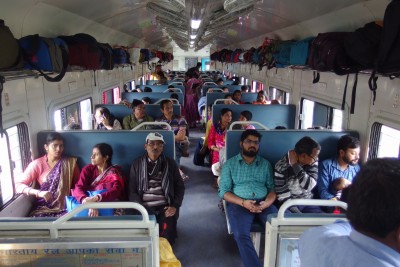 Tripura was pure bliss in comparison with good bus and train connections. We made day trips south of the capital using a mix of relatively good buses and mini-buses. A few prices (per person): Agartala - Matabari (for Sundari Temple): 55 Rs / Udaipur - Agartala: 50 Rs / Agartala - Melagahr (for Neermahal): 45 Rs.
Tripura was pure bliss in comparison with good bus and train connections. We made day trips south of the capital using a mix of relatively good buses and mini-buses. A few prices (per person): Agartala - Matabari (for Sundari Temple): 55 Rs / Udaipur - Agartala: 50 Rs / Agartala - Melagahr (for Neermahal): 45 Rs.
From Dharmanagar to Unakoti, we took a Kailasahar bound Winger which we left at the junction to the site. We paid the full fare to Kailashahar (35 Rs per person), which is normal. Going back was a bit tricky but we were very lucky, click here to read how we managed.
- Agartala to Dharmanagar, train AGTL SCL EXP (15663), three hours 10 minutes (departed 11:00) - price per person 154 Rs Sleeper Class; Tuk-tuk to Agartala station 80 Rs. We used Dharmanagar as a base for visiting the rock sculptures of Unakoti and discovered a very pleasant town. The journey was smooth and very pleasant, we were travelling with a young couple and their baby who told us that they had seen us already at the Neermahal Palace. The man recommended the hotel Unakoti in Dharmanagar (really good) and when he heard that we were heading to Imphal (Manipur) next, he mentioned that the railway line had been extended to Manipur, not yet reaching Imphal but still a good alternative to the route we wanted to take via Silchar. And that's what we decided to do. We did not regret it and were thus able to go from Dharmanagar to Imphal in one day (although the road from Khongsang to Imphal was atrocious, see below).
- Dharmanagar to Khongsang (Manipur), train AGTL KGBP JANSH (12097), five hours (departed 08:40) - price per person 140 Rs Second Seating. Note that this train runs only Mondays, Wednesdays and Fridays. Another smooth and pleasant ride. The train was quite full up to Arunachal Junction (the nearest station to Silchar) where nearly everybody left, leaving the train empty until the border station of Jiribam where the train filled up again particularly with many soldiers. The new portion of line after Jiribam is spectacular, a feat of engineering with many tunnels (not conducive to admiring the scenery but it did not matter), tall bridges over deep valleys, all very impressive.
Manipur
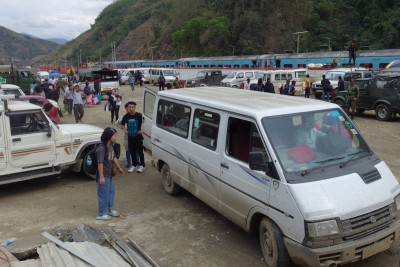 Except for the road from Imphal to Moirang (for Loktak Lake) which has been recently resurfaced thanks to India hosting the G20 in 2023 and a meeting with some international big wigs taking place there in February, the roads in Manipur range from bad to utterly atrocious. We made only one day-trip from Imphal: to Thangka on the shores of Loktak Lake. It involved first a Winger to Moirang (100 Rs) followed by a shared tuk-tuk to Thanga (30 Rs). Prices are per person.
Except for the road from Imphal to Moirang (for Loktak Lake) which has been recently resurfaced thanks to India hosting the G20 in 2023 and a meeting with some international big wigs taking place there in February, the roads in Manipur range from bad to utterly atrocious. We made only one day-trip from Imphal: to Thangka on the shores of Loktak Lake. It involved first a Winger to Moirang (100 Rs) followed by a shared tuk-tuk to Thanga (30 Rs). Prices are per person.
- Khongsang to Imphal, 95 km, four 3/4 hours - Winger 450 Rs per person. The road we took to Imphal, National Highway 37, was everything but a road: it was mostly a muddy track, full of potholes (but really big ones) and peppered with roadworks. The mud was partly caused by the engineering works of the new railway line; we could see the work in progress with half completed bridges, tunnels surging out of the mountains and not yet connected to the tracks and many lorries using the highway to service the various worksites. But there was more to it. The road is closely skirting the hills and the slopes above or below are very steep, with no protection what so ever to secure the soil or the rocks, which means that landslides are very frequent. We had hoped to make better speed once we reached the plain surrounding Imphal, but to no avail: even then the road remained muddy and plagued by potholes. We were really disgusted when we arrived in Imphal and tried to find our guest house in a road equally muddy and broken…
- Imphal to Kohima, 130 km, five 1/2 hours in total - Winger 700 Rs per person. This journey was most annoying. We departed nearly on time (only 20 minutes late) but our driver made a breakfast break just 30 minutes after leaving Imphal. And this break lasted a full hour with the driver vanished and nowhere to be found. All passengers, us included, were fuming and the situation did not improve when we finally continued our journey: our driver was driving painfully slow on an otherwise quite empty road. We had to go through many check posts as we were changing states, although we as foreigners were never checked. The Manipur part of the road was not very good, but luxury compared to Highway 37 and the road improved significantly once we were in Nagaland.
Nagaland
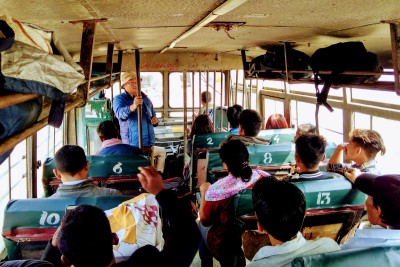 Arriving in Kohima with our Winger from Imphal, we had to be very forceful for the driver to stop in the southern half of the city (P.R. Hill) instead of driving to the ISBT some five km further north, in the middle of nowhere on the road to Dimapur. To be honest, Kohima has a very strict parking and traffic management which we did not realise at the time and stopping at the curb for us to go out was indeed not regular. Fortunately nothing bad came out of it for the driver. A characteristic of Kohima is that there are absolutely NO tuk-tuks in town. Thomas was the first to notice their absence and indeed: no exhaust fumes, no honking, no engine noise, it made such a huge difference. On the other hand, Dimapur is plagued by them, it seemed as all Kohima tuk-tuks had ended down there, a real nightmare.
Arriving in Kohima with our Winger from Imphal, we had to be very forceful for the driver to stop in the southern half of the city (P.R. Hill) instead of driving to the ISBT some five km further north, in the middle of nowhere on the road to Dimapur. To be honest, Kohima has a very strict parking and traffic management which we did not realise at the time and stopping at the curb for us to go out was indeed not regular. Fortunately nothing bad came out of it for the driver. A characteristic of Kohima is that there are absolutely NO tuk-tuks in town. Thomas was the first to notice their absence and indeed: no exhaust fumes, no honking, no engine noise, it made such a huge difference. On the other hand, Dimapur is plagued by them, it seemed as all Kohima tuk-tuks had ended down there, a real nightmare.
- While in Nagaland, we stayed only in Kohima, except for the trek to the Dzükou valley, some 15 km south of P.R.Hill. We took a shared taxi to Zakhama where we wanted to start the trek (80 Rs per person). Coming back we were a bit unsure how it would work: it was a Sunday and we had read everywhere that there was no public transport, no taxi running on Sundays. We decided to try our luck with hitch-hiking and a car stopped very quickly, they would take us but were only going to Zakahma. We thought it was better than nothing and were getting into the car when we were suddenly overtaken by an Imphal-Dimapur bus. And then we had a James Bond moment! Our driver pressed the speed pedal, overtook and stopped in front of the bus while we jumped out waving frantically! The bus stopped and took us on board; it was full, but the distance was small and the journey did not last long. To top it all, the conductor did not want any money from us when he let us out at P.R.Hill. It really worked perfectly, could not have been better.
- Kohima to Dimapur, 65 km, three hours - Taxi to ISBT 250 Rs and Bus 100 Rs per person. This trip for once was uneventful. There was a battered bus waiting to depart when we arrived, we boarded and off we went. The road was good, we were making good speed, only problem were the traffic jams at the entry of Dimapur. Dimapur's bus station is neighbouring the railway station, with many hotels around.
Assam
Assam has the advantage of having a quite extensive railway network, which we experienced first thing when we took the train from Dimapur to Jorhat. The rest of our journeys in this state were made by bus (and a ferry to Majuli). We did a lot of walking while on Majuli; leaving the island was a bit of an adventure…
We were back in Guwahati for a few days at the end of our trip, waiting to catch our night train to Kolkota. As usual we did a lot of walking in the city, and we recommend a trip to North Guwahati on the other side of the Brahmaputra. We took the ropeway to get there (300 Rs per person one way), explored the Govida Krishna Temple and walked west to the Ashwaklanta Mandir from where we took a ferry back to the other side (much cheaper: 5 Rs per person!)
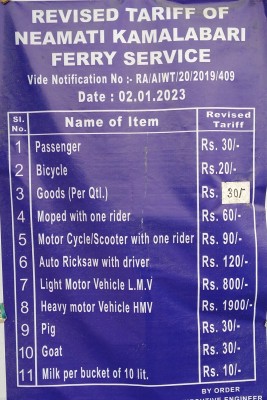 Dimapur to Jorhat, train JANSATABDI EXP (12067), two hours 40 minutes (departed 10:20) - price per person 114 Rs Second Seating. Note that this train does not run on Sundays. All the people we asked in Kohima about the best way to reach Jorhat had told us to get the bus to Dimapur and then board a train, a much better and quicker connection than continuing by road. We followed their advice and confirm, the landscape was flat and the train made its way through tea plantations, rice fields, bamboo groves and woodland. Recommended.
Dimapur to Jorhat, train JANSATABDI EXP (12067), two hours 40 minutes (departed 10:20) - price per person 114 Rs Second Seating. Note that this train does not run on Sundays. All the people we asked in Kohima about the best way to reach Jorhat had told us to get the bus to Dimapur and then board a train, a much better and quicker connection than continuing by road. We followed their advice and confirm, the landscape was flat and the train made its way through tea plantations, rice fields, bamboo groves and woodland. Recommended.- Day trip to Sibsagar from Jorhat - prices per person: outward with Winger 50 Rs, return with Bus 75 Rs. It was not obvious where to catch a transport to Sibsagar: go to the ISBT out of town, or flag a bus in town? We started to walk to the ISBT, looking for potential transport on the way and spotted a minibus waiting at the curb which, yes, was going to Sibsagar. Well, not directly as we found out: it was Dibrughar bound and avoided Sibsagar's centre, dropping passengers instead on the by-pass. We had a bit of an argument with the conductor as he insisted on dropping us west of the city at the start of the by-pass, right in the hands of the tuk-tuk mafia which was eagerly waiting for their prey. But we knew better, thanks to our GPS and held our ground, refusing to leave the minibus. The conductor eventually relented and we left the vehicle with many other passengers at the location we had spotted as best to reach the city centre. Coming back was easier: we took a bus from Sibsagar city centre, the only drawback being that it avoided Jorhat's city centre, using the by-pass to reach the ISBT. We had here again a small argument with the conductor. We had inquired the ticket price at the station: 75 Rs so we gave him 200 Rs expecting some change back, but he claimed that the fare was 100 Rs. We argued and asked for our change, he refused and as Thomas was not letting it go, threatened to throw us out and eventually handed 50 Rs back. This made for interesting entertainment for the rest of the passengers!
- Jorhat to Garamur (Majuli) - Prices per person: Tuk-tuk to Nimati Ghat 75 Rs / Ferry 30 Rs. We advise asking your hotel to check the ferry schedule before setting off, as times vary according to the season. The ferry was full, all passengers crammed under deck, many standing and there was hardly space on the deck (less than 10 persons could stand there) as it was full with motorbikes and even some cars. Although it was raining we made a point of staying on deck, it is not everyday one is "cruising" the Brahmaputra. Alas, we did not see a lot, too much rain and fog. Going to Garamur from the Kamalabari Ghat was easy: our guest house had arranged a pick-up.
- Garamur (Majuli) to North Lakhimpur, three hours 40 minutes, Bus 200 Rs per person. Our next stop was North Lakhimpur (Arunachal Pradesh) and we knew that there were buses leaving Majuli and going north, but it was nearly impossible to get reliable information. Our host phoned somebody who mentioned a bus leaving at 06:00 from a company called Sundran which nobody knew, there was a booth from Network Travels in Garamur but the guy was most unfriendly and irresponsive throwing different times at us, without any further detail: a bus was supposedly leaving Kamalabari at 05:00 or 05:30, driving through Garamur a little later, no booking ahead… And then on the last evening our host suddenly seemed to doubt his bus recommendation and started explaining how we could reach North Lakhimpur with shared tuk-tuks first to Dhakuakhana and then to Gogamukh where we could get a bus to N. Lakhimpur. In the end we were at the Garamur Junction at 04:50, hoping to catch the 05:00 Network Travels bus. We felt relieved when an Indian couple joined us but they were waiting for the 05:00 bus to Dibrughar. Confusion on both sides! And then a bus appeared at 05:10; the couple stormed it, just to go out again and tell us that this bus was going to Guwahati via… North Lakhimpur! Hurrah! The journey was fast and comfortable, they let us out in the town centre, it was all good in the end.
Arunachal Pradesh
And then came Arunachal Pradesh, the state of which we had heard so many awful reports. Well, we were expecting much worse: the roads were good, the only drawback was the length of time involved to reach destinations and the uncomfortable Sumos.
- North Lakhimpur to Ziro, 120 km, five hours - Sumo 600 Rs per person. Our Sumo was due to depart at 09:30, it was 10:10 when we left N. Lakhimpur, crawling to a village out of town where we picked up some passengers and wasted a lot of time loading stuff on the roof, rearranging the load, and waiting for a woman who was gone God knows where. We were happy to leave at last but being back on the highway did not improve our nerves: our driver was still driving painfully slow, his phone glued to his ear. There was a market in the woods not far away from the Assam / Arunachal border where farmers were selling all kind of fresh vegetable and fruits and he stopped to do his shopping, soon joined by one of the passengers who thought it was a good idea. It all lasted good 30 minutes while the rest of the passengers stood stupidly on the side of the road waiting and waiting… But we could leave at last and the rest of the trip was OK. Crossing the border was a non-event, the officers checked our PAPs but did not want to see our passports, they checked our fellow passengers with more caution. The landscape was nice: we drove through huge tea plantations in Assam and the mountain road was good, at times quite impressive, skirting an imposant artificial lake on the way. We had a 45 minutes break at Potin, where our road joined the one coming from Itanagar and drove through to Ziro. The video below has been taken during our journey from North Lakhimpur to Ziro. We were in the middle row, sharing the seat with a young couple, both teachers starting a new job in Ziro; it was a bit cramped but not too bad.
- Ziro to Itanagar, 110 km, four hours - Sumo 550 Rs per person. Our Sumo out of Ziro was not a TATA Sumo but a Force: quite new and comfortable with one passenger seat in front, three in the middle and further two at the back. We were sharing the middle row with an Apatani grand mother which made this journey quite special. We retraced part of the route from three days before, passing again the artificial lake and our driver stopped at a restaurant overlooking the dam so that we could enjoy the scenery in full. A good trip.
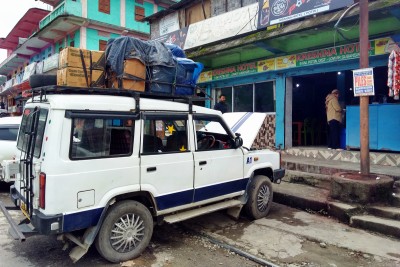 Itanagar to Bomdila, 270 km, eight hours - Sumo 1000 Rs per person. Our seats were in the last row, which means that we did not see much of the scenery in the mountains. To get to Bomdila, we first drove through Assam (such great tea plantations!) and it was quite pleasurable as it was only the two of us at the back, so we could sprawl a bit and see through the windows. But we picked up a woman with her 9 years old son at some point in time, so here we were squeezed again and the seats were too high to see much of the landscape, the front view obscured by the people in front of us. The road was good but the journey simply lasted for what seemed an eternity. The border crossing was completely uneventful, nobody checked us or wanted to see our PAPs (more about this later). No need to say we were happy to reach Bomdila at last.
Itanagar to Bomdila, 270 km, eight hours - Sumo 1000 Rs per person. Our seats were in the last row, which means that we did not see much of the scenery in the mountains. To get to Bomdila, we first drove through Assam (such great tea plantations!) and it was quite pleasurable as it was only the two of us at the back, so we could sprawl a bit and see through the windows. But we picked up a woman with her 9 years old son at some point in time, so here we were squeezed again and the seats were too high to see much of the landscape, the front view obscured by the people in front of us. The road was good but the journey simply lasted for what seemed an eternity. The border crossing was completely uneventful, nobody checked us or wanted to see our PAPs (more about this later). No need to say we were happy to reach Bomdila at last.- Bomdila to Tawang (and back), 180 km, eight hours - Sumo 700 Rs (one way) per person The journey up to Tawang was a gruelling drive: Thomas was in the middle row with no window seat, I had a window seat but sat in the back row. Four full adults sitting next to each other for eight hours is very uncomfortable, specially in road bends when people get jolted to the right or to the left, squeezing each other or when some of them fall asleep and start tilting in your direction… One has to "fight" for space, the legs start having cramps, the bottom hurts… But the mountain scenery was impressive as the road winded its way up the Se La (a high altitude pass at 4170 m) and then dropped down to Tawang (3048 m). There was still a little snow at Se La (where we had a photo stop) and it was bitterly cold and windy. The return journey was uneventful and better than going up; we were in the middle row and could enjoy the scenery, the driver stopped at Se La again for more photos opportunities.
- Bomdila to Tezpur, 150 km, five hours - Sumo 700 Rs per person Our last Sumo! We took a late one, leaving Bomdila at 11:00 and arrived accordingly late in Tezpur, so much more that our driver was driving really slow taking some strange small country roads instead of the highway with no obvious purpose. There was a bit of trouble at the border in Bhalukpong: we waved our PAPs, it was OK and then we had to go to an office to sign ourselves out of Arunachal Pradesh. BUT. If you remember, nobody had checked our PAPs on the way to Arunachal which meant that we had not signed the "big book of foreigners" at the time. So the officer in charge had a problem: how could we go out, when we did not get in? He finally resorted to making a late registration as an addendum in his big book: we told him date and approximate time of our passing and we were done.
- Tezpur to Guwahati, 180 km, four and a half hours - price per person: ASTC Bus 315 Rs, Guwahati City-Bus 25 Rs. Our last long journey in the north east. We took an AC bus and I was looking forward to crossing the Brahmaputra again, alas our bus windows were covered by a coloured foil advertising I don't remember what, so that we could not see a thing. It was so frustrating, staring ahead in the bus waiting for the time to go by. There was a big traffic jam when we arrived in the outskirts of Guwahati. We did not go to the ISBT (too far away from the centre) but left the bus at the beginning of GS road with many other passengers and crossed the highway; there were many city-buses going to Paltan Bazaar waiting on the other side.
Want to read more? Go back to Some Planning Links or go on to Why India needs a big BRO or go up to Blog
$ updated from: Blog.htxt Mon 28 Apr 2025 14:55:27 trvl2 — Copyright © 2025 Vero and Thomas Lauer unless otherwise stated | All rights reserved $



